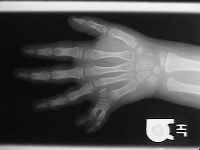- See:
- Polydactyly of the Thumb:
- Polydacyly of the Foot:
- Discussion:
- polydactyly is most common hand anomaly;
- may involve autosomal dominant transmission in which case an asociatted syndrome is generally not present;
- when a genetic syndrome is present, transmission tends to occur in a recessive pattern;
- central polydactyly is often inherited w/ an associated with syndactyly;
- about 10 times more common in blacks than whites;
- polydactyly of one or more supernumerary digits is most often post-axial involving an extra little finger;
- although pts function well, the deformity is unacceptable cosmetically in many cultures;
- Exam:
- digits may be abnormally short (brachydactyly), a consequence of short or missing phalanges;
- Classification:
- type I: extra soft tissue only (treated w/ ligation in nursery)
- type II: includes bone, tendon, and cartilage;
- type III: completely developed with own metacarpal (rare);
- Treatment: Post-Axial Nubbin:
- if radiograph demonstrates no bone in the post axial duplicated digit, it may be removed in the newborn nursery, through ligation;
- note: suture ligation is not usually performed in older infants;
- w/ more developed digit, formal surgical amputation should be performed;
- good web space should be preserved and the digit removed;
- w/ polydactyly of the small finger, the abductor digiti minimi needs to be attached to the retained digit








